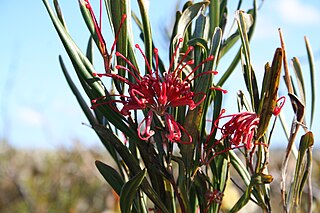
Grevillea oleoides, also known as red spider flower, is a shrub which is endemic to New South Wales in Australia.
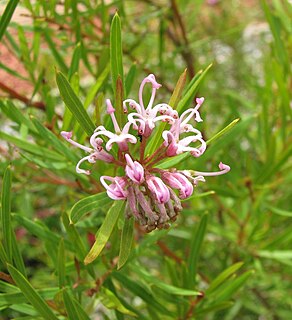
Grevillea sericea, commonly known as the pink spider flower, is a shrub endemic to New South Wales, Australia.
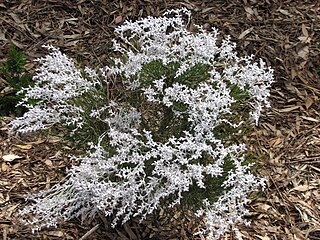
Conospermum stoechadis, commonly known as common smokebush, is a shrub endemic to Western Australia.
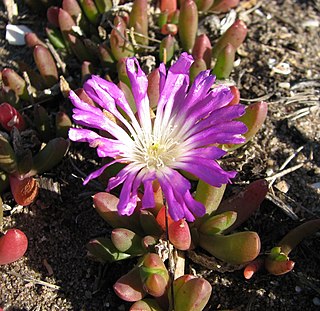
Disphyma is a monotypic genus of succulent shrubs. Commonly known as round-leaved pigface, New Zealand iceplant and purple dewplant, it occurs in South Africa, Australia and New Zealand. Its sole species, Disphyma crassifolium, is divided into two subspecies, D. crassifolium subsp. crassifolium and D. crassifolium subsp. clavellatum.

Disphyma crassifolium subsp. clavellatum is the subspecies of Disphyma crassifolium that occurs in Australia and New Zealand. It is sometimes known by the common name rounded noon-flower
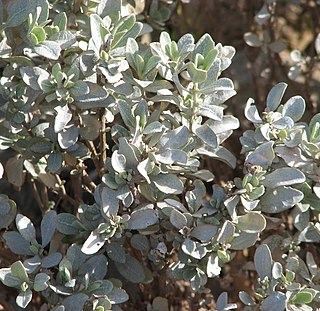
Atriplex vesicaria, commonly known as bladder saltbush, is a species of saltbush endemic to Australia.

Pimelea flava is a shrub in the family Thymelaeaceae which is endemic to Australia.
Nicotiana occidentalis, commonly known as native tobacco, is a short-lived herb native to Australia.

Xanthorrhoea fulva is a species of grasstree of the genus Xanthorrhoea native to New South Wales and Queensland. It was previously regarded as a subspecies of Xanthorrhoea resinosa, but reclassified as a species in its own right in 1986.

Xanthorrhoea arborea a species of grasstree of the genus Xanthorrhoea native to New South Wales and Queensland. It was one of the many species authored by the Scottish botanist Robert Brown.

Philotheca myoporoides, commonly known as long-leaf wax flower, is a shrub in the family Rutaceae. The species is endemic to south-eastern Australia. It is usually up to 2 metres high and produces white flowers in spring and autumn.

Leptospermum polygalifolium, commonly known as tantoon, is a species of shrub of the family Myrtaceae native to eastern Australia and Lord Howe Island. Six subspecies are recognised, though there is significant intergradation between them.

Hibbertia cistiflora, commonly known as Rock Rose Guinea-flower, is a shrub species that is native to eastern Australia. It grows to 100 cm high and has linear leaves to 10 mm long. Yellow flowers with five petals appear in spring.
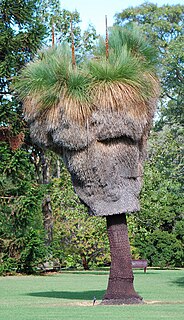
Xanthorrhoea malacophylla is a species of grasstree of the genus Xanthorrhoea. It is endemic to New South Wales, Australia. Mature plants form a single or branched trunk that ranges between 2 and 6 metres in height. The grass-like leaves, which are usually around 3 mm wide, are distinguished from other species by their softness and sponginess. The flowers appear between May and September in scapes that are between 1.3 and 1.8 metres long.

Allocasuarina inophloia, also known as woolly oak, or stringybark she-oak, is a shrub or small tree of the she-oak family Casuarinaceae endemic to inland New South Wales and Queensland. The hairy bark is an unusual feature.
Grevillea kedumbensis is a shrub which is endemic to a restricted locale in the Great Dividing Range in central New South Wales in Australia.

Grevillea ramosissima, commonly known as fan grevillea, is a shrub species of the family Proteaceae. It is native to south-eastern Australia.
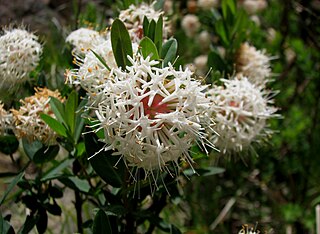
Pimelea ligustrina, commonly known as tall rice-flower, is a shrub species in the family Thymelaeaceae. It is endemic to south-eastern Australia.
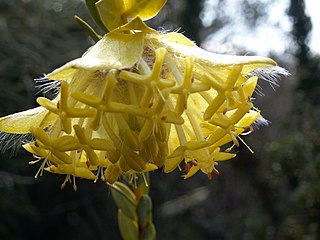
Pimelea suaveolens, commonly known as the scented banjine or silky-yellow banjine is a slender shrub with large, rather hairy yellow inflorescences. It ranges in forest areas of the south-west of Western Australia from New Norcia to Albany.
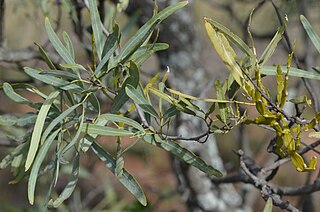
Korthalsella rubra is a flowering plant in the Santalaceae (sandalwood) family, formerly placed in the Viscaceae.

















